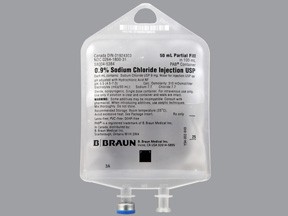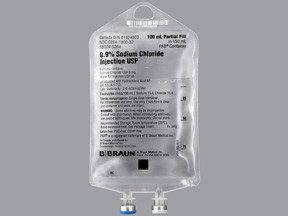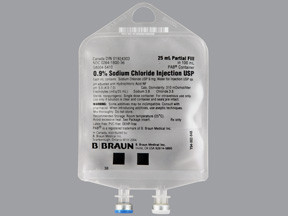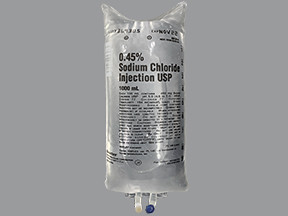SODIUM CHLORIDE SOLUTION - INTRAVENOUS
PHONETIC PRONUNCIATION: (SOE-dee-um KLOR-ide)
GENERIC NAME(S): 0.9 % sodium chloride
Uses
USES: This solution is used to supply water and salt (sodium chloride) to the body. Sodium chloride solution may also be mixed with other medications given by injection into a vein.
How to use SODIUM CHLORIDE SOLUTION - INTRAVENOUS
HOW TO USE: This solution is usually given by injection into a vein as directed by your doctor. It may be given in the hospital, in a clinic, or at home. If you are using this product at home, learn all preparation and usage instructions from your health care professional. Before using, check this product visually for particles or discoloration. If either is present, do not use the liquid. If you are mixing this solution with another medication, ask your doctor or pharmacist if it is proper to mix it with the medication. Learn how to store and discard medical supplies safely. The dosage is based on your age, weight, medical condition, and response to treatment.
Side Effects
Precautions
Interactions
Overdose
Images
Reviews
Faq for SODIUM CHLORIDE SOLUTION - INTRAVENOUS
Sodium chloride solution intravenous, commonly known as saline solution, is a sterile solution of sodium chloride (salt) in water. It is used for various medical purposes, including rehydration, dilution of medications, and as a vehicle for intravenous administration of drugs.
Sodium chloride solution intravenous is administered through a needle or catheter inserted into a vein. It is typically given as a slow infusion or drip, under the supervision of healthcare professionals.
The concentration of sodium chloride in intravenous solutions can vary. The most commonly used concentrations are 0.9% (normal saline) and 0.45% (half-normal saline). These concentrations mimic the salt content of the human body and are commonly used for various medical purposes.
Sodium chloride solution intravenous is indicated for various medical conditions, including dehydration, electrolyte imbalances, hypovolemia (low blood volume), fluid replacement during surgeries or medical procedures, and as a vehicle for intravenous medications.
While sodium chloride solution intravenous is generally safe, some rare side effects may occur. These can include fluid overload, electrolyte imbalances, allergic reactions, and infection at the injection site. It is essential to use the solution as prescribed by healthcare professionals and monitor patients for any adverse reactions.
Sodium chloride solution intravenous is generally considered safe to use during pregnancy and breastfeeding. However, it is always recommended to consult with a healthcare provider before using any medications or solutions while pregnant or breastfeeding.
Sodium chloride solution intravenous is available both with and without a prescription, depending on the specific concentration and intended use. Lower concentrations and smaller volumes may be available over-the-counter, while higher concentrations or larger volumes may require a prescription.
Yes, sodium chloride solution intravenous can be used for children under medical supervision. The dosage and administration should be determined by a healthcare professional based on the child's age, condition, and specific needs.
Sodium chloride solution intravenous should be stored at room temperature, away from direct sunlight, and out of the reach of children. Always follow the storage instructions provided by the manufacturer or healthcare professional.
Disclaimer
IMPORTANT: HOW TO USE THIS INFORMATION: This is a summary and does NOT have all possible information about this product. This information does not assure that this product is safe, effective, or appropriate for you. This information is not individual medical advice and does not substitute for the advice of your health care professional. Always ask your health care professional for complete information about this product and your specific health needs.






No Reviews Yet